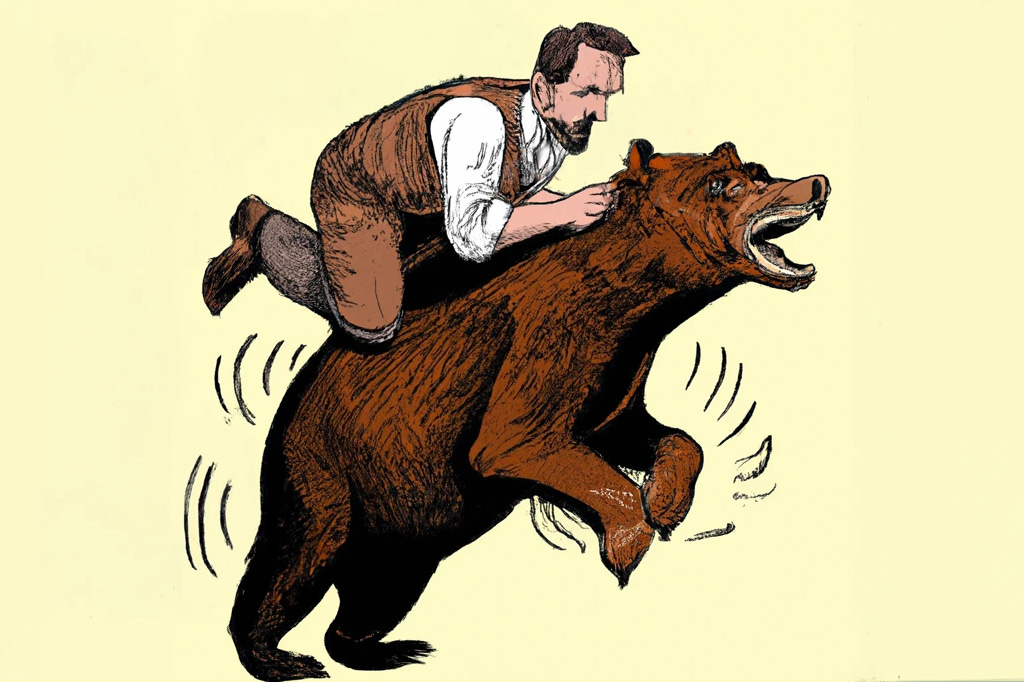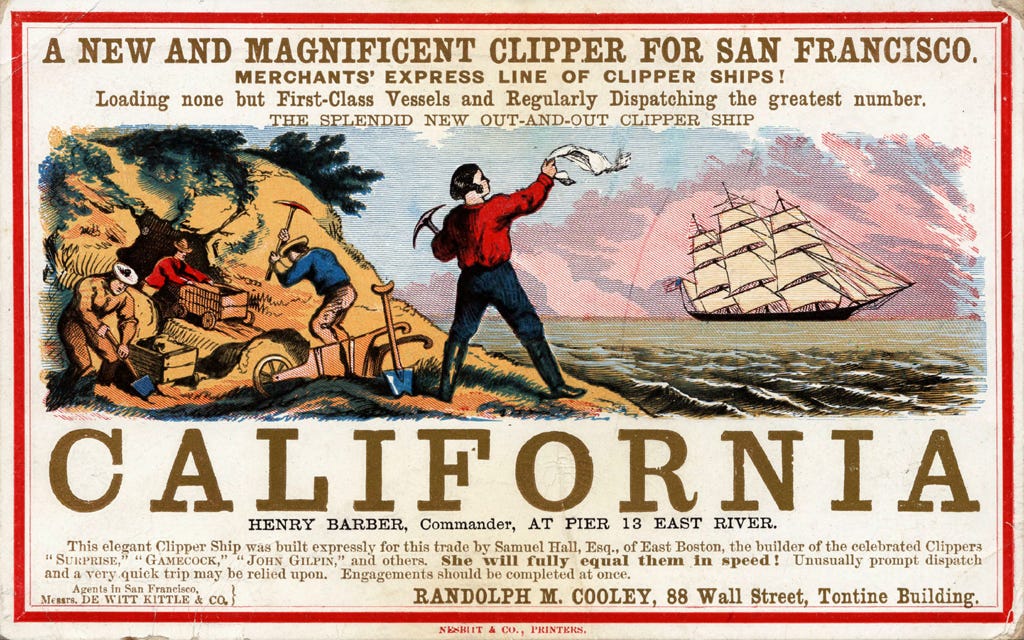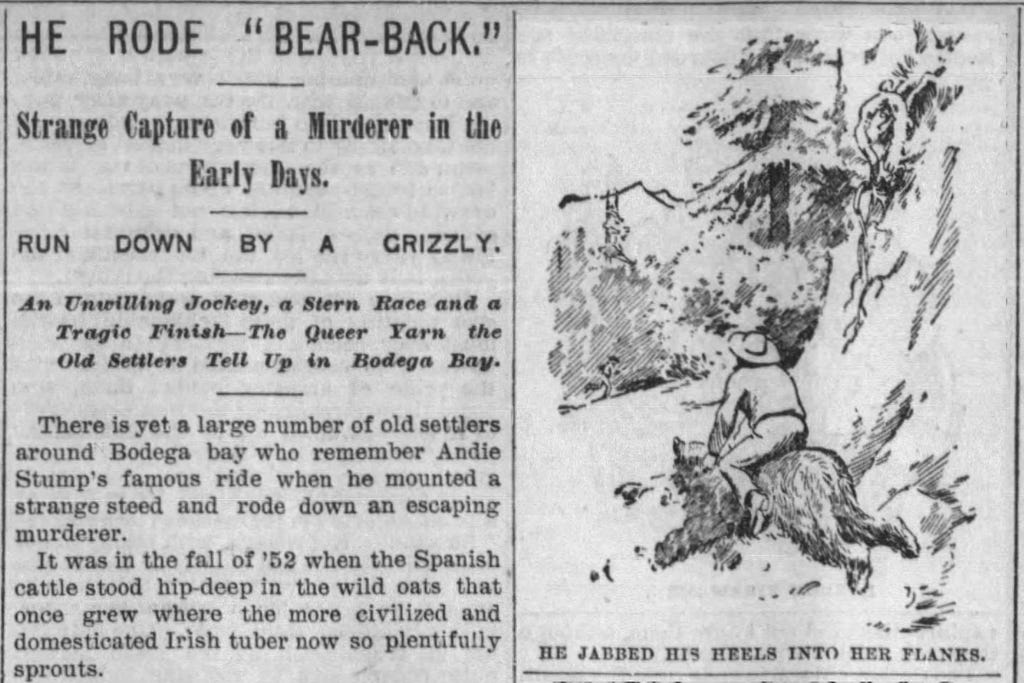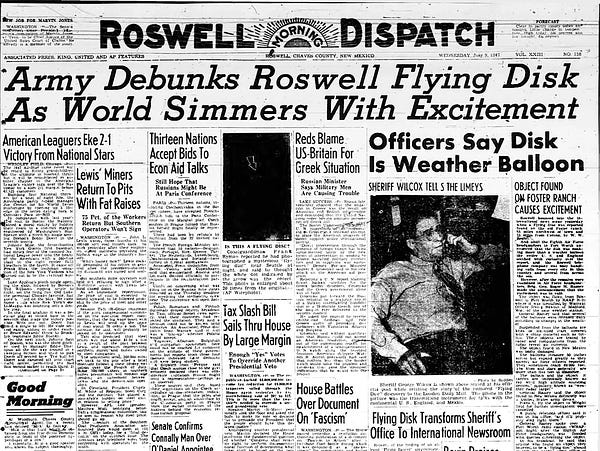The Man Who Rode the Bear
A fleeing murderer and a furious grizzly; PLUS WWI trenches, WWII landing craft, and America's first serial killer

UPDATE: The Man Who Rode The Bear is now a podcast. Listen here:
How does a man become a legend? How does he get written into a fireside tale? How does he become the sort of man who, late in life, is approached on the street and introduced to children as a local hero? It is through the stories he tells and the stories told about him. Extraordinary stories. Long-ago tales that cannot be verified but are believed by many to be true.
If such a story takes place in a small town, perhaps in a pioneer settlement in the old west, it can become part of the heritage of the place, and its protagonist a figure of folklore. But it must be a good story. Perhaps one involving a mysterious disappearance, an alleged murder, and a furious bear. The hero of that tale might live long in the memories of his fellow townsfolk, even if he remained virtually unknown to the rest of the world.
The hero of this tale is Andy Stump. He came to Sonoma County from West Virginia during the California gold rush, when the chance of striking rich drew hundreds of thousands of forty-niners to the northern goldfields. But Stump didn’t come to pan for nuggets. There were no dreams of gold to the west of the Sierra Nevada at this time. These were the middle decades of the 1800s, when California was a land of discovery that was shifting from Mexican to American hands.
Old trappers who crossed the mountains reported the Sonoma Valley as a “fair and goodly” land. The soil was fertile, and the fields were filled with lush grasses and colorful flowers that swayed and swirled in the coastal breeze. The redwoods were the real bounty. A swathe of stately evergreens swept across basins and ravines, over hills and mountains. Few men had ever traversed the forests; the only trails were those carved out by deer, elk, and grizzly bears.
In 1846, a sea captain named Stephen Smith had brought ashore what was probably California’s first steam engine and set up a steam-powered sawmill at a town called Bodega, about 45 miles north of San Francisco. Smith’s men – sombrero-wearing rancheros, old-time soldiers, drifted prospectors – felled the redwoods and rolled them to the mill, where a whirring saw sliced the logs into timber planks. This fresh-cut lumber was hauled down to Bodega Bay and exported to the Sandwich Islands – the settlers’ name for Hawaii.
Smith and other Sonoma settlers flew a flag over their properties featuring a star and a grizzly bear. This was the Bear Flag, the symbol of a revolt by American settlers against the Mexican government. The grizzly bear, the powerful symbol of the breakaway California Republic, had once been numerous in these parts. But it was being hunted toward extinction by settlers for its meat and by ranchers to protect their livestock. The grizzly was depleted in numbers, retreating from man, fighting to survive.
‘Stump, upset about his missing friend, accused West of “doing away” with Roy for his money.’
In 1850, Smith leased the mill and his forestland to a pair of Easterners named Hanks and Mudge. This was the year California became the 31st state. It was around this time that Andy Stump arrived in Bodega. He was 23 years old in 1850, 5 feet 4 inches, 173 pounds, blue-eyed, and tough as work boots. The eldest son of a large family, he came to California from Randolph County on the western slopes of the Blue Ridge Mountains. His parents and somewhere between twelve and twenty siblings would follow him out to Sonoma. The Stumps would become an important pioneering family in the area. (The father, Germany-born John C Stump, would open a saloon in Bodega known as the American Hotel.) But when he first arrived, alone and in need of work, Andy Stump was drawn to the noise and sawdust and sweet-cut smell of the mill.
Here Stump got friendly with a worker known as “Jersey” Roy – so-called because he came from New Jersey. Roy had worked many jobs along the west coast and earned a little fortune in gold dust, which he kept in a broad money belt strapped around his body. Now he was working at the mill to see out time until a steamer was ready to carry him on his long journey back east. It was said Roy clasped that belt night and day closer than a brother. Then one day, Roy disappeared. The strange thing was he never said goodbye.
It was several months later that a letter arrived at the mill. It came from Roy’s family and asked for information about him. Neither Roy nor any word from him had ever reached home. Suspicious eyes turned to a worker named Tony West. He was a relative newcomer to the area, with no family or connections. And he did not have a very likable disposition. Someone said they’d seen West heading into the forest with Roy around the time he vanished. West said he had innocently accompanied Roy on the first part of his journey home. There was no evidence he was involved in Roy’s disappearance. But the simmering suspicion began to boil over.
It was now the fall of 1852, and Stump and West got into an altercation. At a meeting of workers outside the mill, Stump, upset about his missing friend, accused West of “doing away” with Roy for his money. West claimed innocence, but the accusation had struck him like an arrow. He turned pale, eyes wide with fear, and backed away toward his cabin. Then, suddenly, West turned on his heels and broke downhill for the tree line. Would an innocent man run? Stump thought not. He bolted after West, followed by a crowd of fellow workers. They weaved past stacked lumber and leaped over fallen logs toward the expanse of forest that fell away below them. The chase was on.
Stump and the mob of mill men tumbled through the wooded valley, squeezing between trees, scratching through thickets, and wading across streams. Branches whipped at their arms and tore their shirts, and berry vines snagged at their legs and ripped their trousers. It was a long chase. Minutes turned into miles. The forest became thicker, the incline steeper. The men tripped and stumbled, lungs burning, limbs bleeding. One by one, exhausted and bloodied, the mill workers gave up the chase. Eventually, two men were left racing through the valley – Tony West and Andy Stump.
The forest was dense now, the tree canopy choking out the light. Stump kept losing sight of West. But he could hear him crashing through the dark tangle of undergrowth, and he stayed relentlessly on his tail. Stump was closing, 20 yards behind, then 15 yards. Suddenly, the two men burst out into a clearing. In front of them gaped a canyon, deep and steep, with a creek at the bottom. Stump saw West hesitate for a second, then desperately jump over the canyon edge. Stump, propelled by momentum and bloody determination, leaped over the edge after him.
Stump crashed and tumbled through the brush and saplings that lined the canyon walls, unable to control his descent. Ahead of him, he heard the crash and tumble of West. Then he heard a thunderous, angry roar. As Stump bounced and somersaulted into the air, he caught a brief glimpse below him of an extraordinary scene.
West had stumbled – literally – upon a huge female grizzly bear and two cubs. One of the cubs, perhaps bundled over when West crashed through their den, was rolling around and howling with fright. Now, propelled by terror, West was hurtling away. Mama grizzly, her seething anger thick in the air, was springing after him. Stump had only a split second to process this picture and no time or means to react. Desperate snatches at branches could not slow his fall. He crashed down – right onto the back of the great big bear.
‘With kitchen-knife claws and a vice-clamp jaw, this was ursus horribilis – the terrible bear.’
The grizzly was California’s biggest and most formidable animal. At its largest, it could be four feet high at the shoulder and seven feet tall when rearing on hind legs. When fat, the grizzly could weigh a thousand pounds – perhaps six times heavier than Andy Stump. It was covered in thick, wiry brown hair and had a characteristic hump between its shoulders. With kitchen-knife claws and a vice-clamp jaw, this was ursus horribilis – the terrible bear.
Stump would later say he was not an intelligent man, but he was a lucky one. Here, good fortune decided to land him perfectly astride the bear’s broad back, like a rodeo bull rider. An experienced horseman who had tamed wild mustangs, Stump’s survival instincts kicked in. He grabbed two fistfuls of the beast’s hair and dug his heels into her flanks. Now he was on for the ride.
The bear did not seem to notice Stump’s arrival, or in any case did not care. Without breaking stride, the grizzly bounded after West – the real object of her rage. The tumbling West and the thundering bear reached a trail that ran along the creek bank. Now West – almost naked, with his shredded clothes hanging from his battered body – found his feet and resumed his desperate sprint, closely followed by the pounding grizzly.
Stump held on for dear life, burying his head in the bear’s coat, partly to protect his face from branches and briars and partly to avoid close inspection of the situation. At some point, the grizzly would tire of its rider and buck him from its back. Then, with just one swipe of a paw or one clench of a jaw, Stump knew he would be dead.
After a few hundred yards, the bear began to slow. Desperate that West should not escape, Stump yelled at the bear and jabbed his heels deeper into her sides. But this only reminded the bear of the nuisance on its back that was slowing her pursuit. Stump realized his ride was coming to an end, and he had one chance to avoid becoming bear food. Eyeing the creek, he raised himself up and threw himself from the back of the bear over the edge of the riverbank, plunging eighteen or twenty feet into the water.
Fearing the bear would follow him into the creek, Stump held his breath, dived under the water, and swam to the opposite bank. When he surfaced, he could not see the bear but could hear the sounds of pursuit downstream. Without her rider to slow her down, Mama grizzly was continuing her chase of West. Stump pulled himself from the creek and, bruised and bleeding and with his clothes in shreds, slowly dragged his sore legs in the opposite direction – back up the valley to the mill.
The following day, a posse of millworkers armed for bear hunting followed Stump into the forest. Along the way, Stump pointed out evidence – broken trees, bloody trails, the disturbed bear’s den – to back up his story. The men reached the spot where Stump had jumped from his ride and continued down the trail. After a quarter of a mile, they found West. He had been mauled to death.
As they headed back up the trail, near the bear’s den, they found the remains of another body – Jersey Roy. There was no sign of his money belt. Although the bears had partially eaten Roy’s body, the men could see that his throat had been cut with a knife. This, they decided, was evidence that Tony West had murdered Jersey Roy and that the grizzly bear had caught the criminal and inflicted maximum justice.
Andy Stump’s story circulated Sonoma County and reached as far as Oakland and San Francisco. It was told at saloon bars and dinner tables. “Some scoffed at the tale, others considered it probable, and a few believed in it toto,” recalled the old Bodega historian Howard C McCaughey. “The original storyteller himself, when questioned, always took on the solemnity of an owl and maintained it to be the truth. No one was able to provide testimony that refuted it.” Records show that Stump retained one piece of evidence to the end of his life – a scar across his forehead.
“Some scoffed at the tale, others considered it probable, and a few believed in it toto.”
As for the grizzly bear, it lost its battle with the California settlers. The great beasts were trapped, shot, and poisoned, bounties were placed on them, and they were baited (often against bulls) as sideshow entertainments. Another show, in San Francisco in the 1850s, featured California trapper John ‘Grizzly’ Adams and his menagerie of captured bears, including several “very awkward but very playful” cubs.
In 1911, a version of the Bear Flag was adopted as the official state flag of California. The grizzly bear pictured on the flag is thought to be Monarch, a 1,100-pound male captured for William Randolph Hearst. Monarch spent the last 22 years of his life in a cage before being stuffed and mounted. Despite becoming an enduring symbol of the state, the California grizzly has been extinct since the 1920s.
Andy Stump settled in Bodega. He became a successful farmer and a dairyman. Stump owned the first grain thresher in the county, brought the first Jersey cows to California, and patented a new design for a butter churn. He held a stake in a schooner that shipped his wares to San Francisco. Stump’s first wife, Harriet, died along with the eldest of their three infant children from typhoid in 1861. Stump later married an Irish girl, Annie, and they had at least six children. Their home was known as the Andy Stump Ranch.
He remained best known for what area newspapers called his “bear-back ride,” but there were other stories, too. In 1880, Stump found a whale that had washed up on the beach at Salmon Creek and claimed it for its oil. A few years later, Stump’s schooner, the JH Congdon, was lost after a collision at sea. About 50 boxes of shipwrecked butter were picked up by dairymen south of Bodega at Tomales Bay. On another occasion, a skunk got into Stump’s dairy and tainted the butter. The batch went out anyway, and a broker wrote that people were asking for more butter with that unusual flavor.
Stump also became involved in disputes on a Native American Rancheria that was situated on his land. Although Stump had no quarrel with the Indians, they would often fight among themselves, and Stump would go out at night to settle things while his wife and children huddled in their home, fearing they might be murdered. According to his family, Stump was a calming presence who could always restore peace to the property.
In 1898, a gold strike was claimed at the Stump Ranch. By then, Stump was 71 years old. Five years later, he was critically injured in a buggy accident. Friends feared he wouldn’t recover, but he did – although it was time to sell the ranch. After Annie died in 1905, Stump lived with one of his sons in Monte Rio.
Stump, “a well-known pioneer,” died at 85 in 1913. It was during the last years of his life that folk approached the old-timer and introduced him to their children as “the man who rode the bear.” Would he, perhaps, tell them the story? Of course he would – with the solemnity of an owl. ◆
With thanks to Robin Rudderow, Archivist, Rancho Bodega Historical Society.
This is a work of non-fiction. Sources and references available on request.
© Paul Brown. All rights reserved. Agent: Richard Pike @ C&W
Thanks for reading Singular Discoveries. Now some recommendations:
Recommended:
Film: All Quiet on the Western Front (Netflix)
This powerful First World War movie tells its story from the perspective of the German trenches. It’s an adaptation of the German language book by Erich Maria Remarque that hurls the viewer into the hell and futility of war. Do read Scottish screenwriter Lesley Patterson’s story of how she funded her dream of producing the movie via triathlon competitions in the Hollywood Reporter. Patterson will likely win an Oscar at the 95th Academy Awards in March. Watch the film on Netflix.
Book: The Midnight Assassin by Skip Hollandsworth (2015)
Skip Hollandsworth is a journalist for Texas Monthly, which has long been one of the best publications for true crime features. In this immersive book, he tells the story of the hunt for the murderer he calls America’s first serial killer in Austin in the 1880s. Austin’s Midnight Assassin pre-dated London’s Jack the Ripper by three years. Some suspected the Assassin and the Ripper were the same man... Get the book at Amazon.*
Book: The Search by John Henry Phillips (2022)
Author John Henry Phillips met veteran Patrick Thomas due to a hotel room mix-up at a D-Day reunion. The meeting led to a touching friendship and to a search for the wreck of Patrick’s landing craft, which was sunk off the Normandy coast. The result is a tremendous read, as John tells the story of the search and the story of the ship and its crew, with Patrick a lively presence. Get the book at Amazon.* Also look out for John’s documentary No Roses on a Sailor’s Grave.
You can find all our recommended books on the Singular Discoveries Amazon bookshelf.*
Meanwhile, over on Twitter:
More next time. In the meantime, please subscribe and tell all your friends.
UPDATE: The Man Who Rode The Bear is now a podcast. Listen here.
Ads: Links marked with an asterisk (*) are affiliate links. If you use them, we may receive a small payment to help run this free newsletter.










